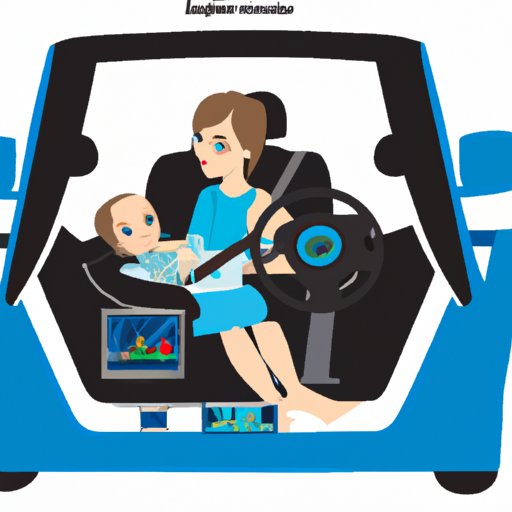
Introduction
After undergoing a cesarean section (c-section) procedure, women need to take ample time to recover before resuming everyday activities—including driving. A c-section is a surgical procedure that requires a longer healing process than vaginal birth, and you need to be aware of when it is safe to start driving again after your surgery.
In this article, we will explain the recommended timeline for resuming driving after a c-section, factors that can affect recovery time, precautions to take for a safe driving experience, tips for a smooth driving experience, why doctors recommend waiting before driving after a c-section, personal stories from mothers regarding their experiences with driving after a c-section, and things to consider before getting behind the wheel post-c-section.
A Step-by-Step Guide on When to Start Driving Again After a C-Section
Recommended timelines by doctors
Doctors typically recommend waiting a minimum of six weeks before resuming any strenuous activity, including driving after undergoing a cesarean section. This timeline might vary for some mothers, especially those who endured complications during labor or surgery.
Factors that can affect recovery time
Factors that can affect the recovery time for new mothers include the type of cesarean section, the amount of time spent under anesthesia and medication for pain relief, and complications with wound healing.
Signs that indicate it’s safe to start driving again
Before returning to driving, you should ensure that you are free from pain, have the mobility to operate the pedals and steer the wheel effectively, and have the ability to wear your seatbelt properly without discomfort.
Precautions to take for a safe driving experience
Before starting to drive, it is essential to prepare ahead of time, stretch your muscles to prevent cramping and stiffness, and wear comfortable shoes and clothing. Additionally, it is advisable to bring along a support pillow—especially while driving on uneven or bumpy roads—and avoid driving long distances in the first few weeks after surgery.
Tips for a Smooth Driving Experience Post-C-Section
Recommended driving positions and strategies
To have a comfortable driving experience, it is essential to find a driving position that places minimal strain on your healing surgical incision. A good position is one where you can comfortably apply the brake, accelerate, and steer your car without any pain. You can use a lumbar pillow to support your lower back and adjust your car’s seat and steering to a comfortable height.
Planning ahead for breaks and rest stops
It would be best to take breaks and rest stops when driving after a c-section, even if it’s a short distance trip. You can plan to take breaks every thirty to forty-five minutes of continuous driving, stretch your legs and arms, and walk about to prevent blood clots and muscle soreness.
Suggestions for items to keep in the car for comfort and convenience
You might want to keep items like a water bottle, snacks, extra pillows, and support cushions in the car on your first few driving trips post-c-section. These items can help you stay comfortable and hydrated during the journey.
The Science Behind Why Doctors Recommend Waiting Before Driving After a C-Section
Explanation of the physical trauma from the procedure
After undergoing a c-section, the body needs time to heal from the procedure’s physical trauma and adapt back to normal life. Your doctor will monitor your recovery process and advise you when it is safe to resume activities like driving.
Impact of anesthesia and pain medication on coordination and reaction times
The effects of anesthesia and pain medication can persist in your system even weeks after the surgery. These medications can affect your coordination and reaction times, making it unsafe for you to drive.
Risks of driving too soon after a c-section
Driving too soon after a c-section can be dangerous for both the mother and the baby, as it may cause physical discomfort, hinder wound healing, and affect the mother’s ability to care for the baby.
Personal Stories from Mothers Regarding Their Experiences with Driving After a C-Section
Real-life accounts from mothers who have gone through c-sections and the challenges they faced while driving
Several mothers who have been through the c-section process shared their experiences with driving after surgery. Some expressed concern about the incision site, while others felt dizzy while driving. Others experienced and managed discomfort with medications.
Examples of strategies that worked for them
Some mothers who had c-sections shared strategies that worked for them while driving post-surgery, such as using support pillows, taking frequent breaks, adjusting their seat positions to minimize the pressure on the surgical incision, and waiting till after their post-operative doctor appointment to start driving.
Things to Consider Before Getting Behind the Wheel Post-C-Section
Legal implications of driving too soon
If you drive too soon after a c-section and something goes wrong, you could be liable for legal actions. It is always advisable to wait until a doctor clears you before resuming any driving activity.
Possible risks to the mother and baby
Driving before your body is ready can lead to injury to yourself as well as the baby. It is always best to have support from someone to help with baby-related needs during the first few weeks after the surgery.
Advice on when to seek professional help for any complications
If you experience any complications related to healing after a c-section surgery, it is crucial to seek professional help immediately. You can call the healthcare provider for post-op appointments or consult with a medical team to gauge the severity of your condition and determine appropriate steps for healing.
Conclusion
As a new mother who has recently undergone c-section surgery, it is important to take your time and recover before resuming activities like driving. Disregarding the recovery timeline can result in both physical and legal dangers. With proper preparation and precautions, you can resume driving safely, while prioritizing your recovery and the safety of your baby.




